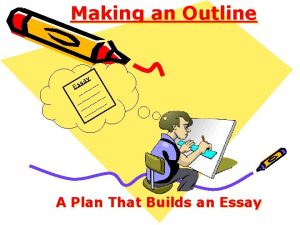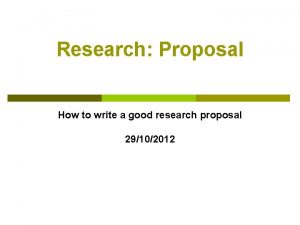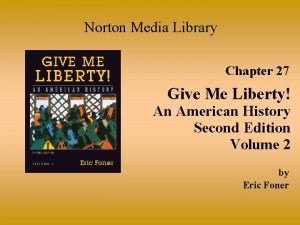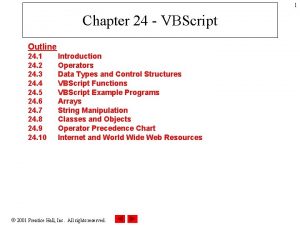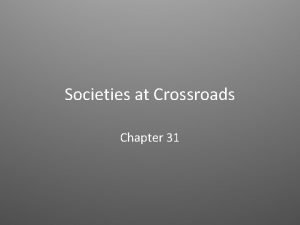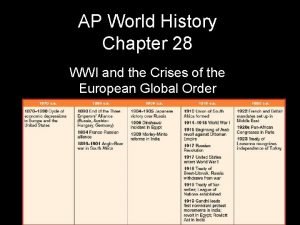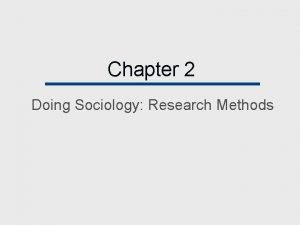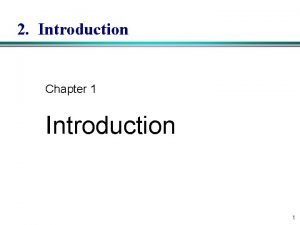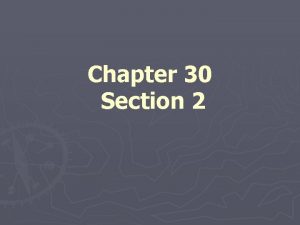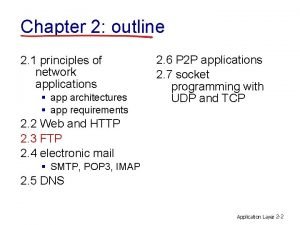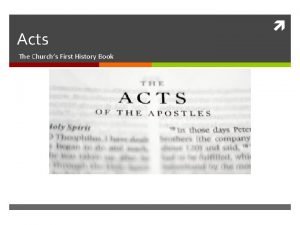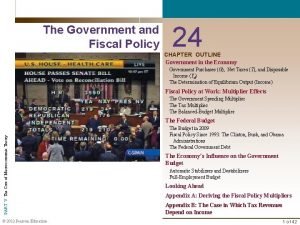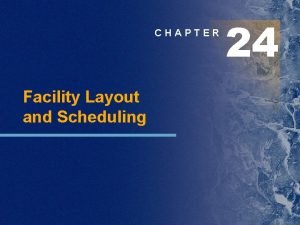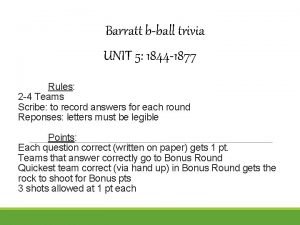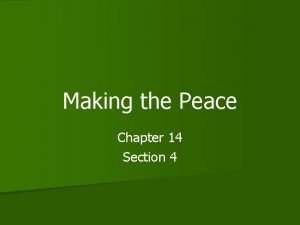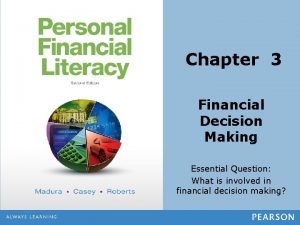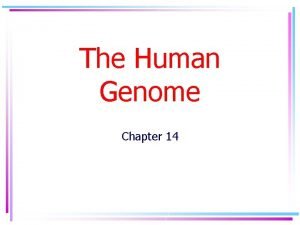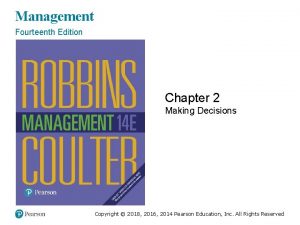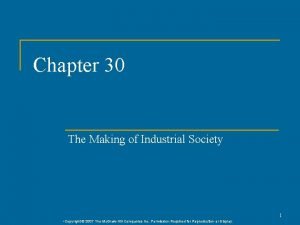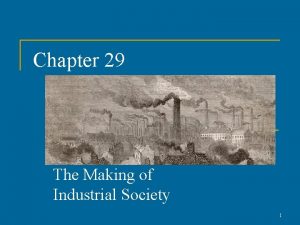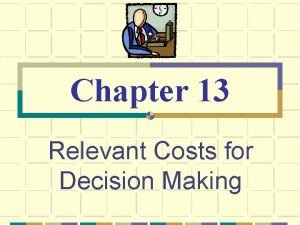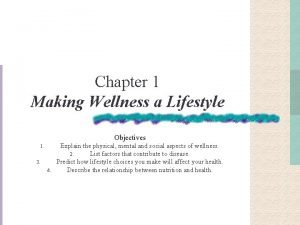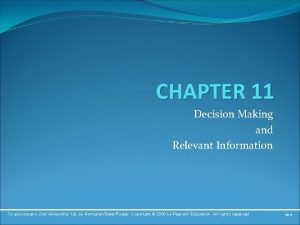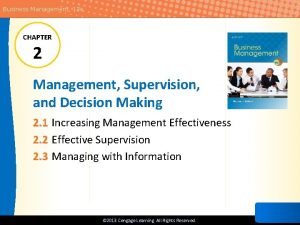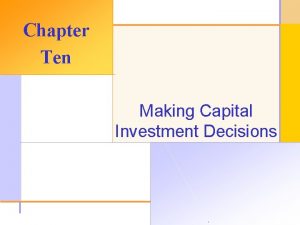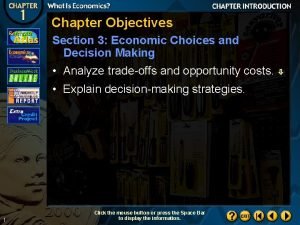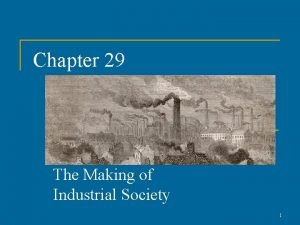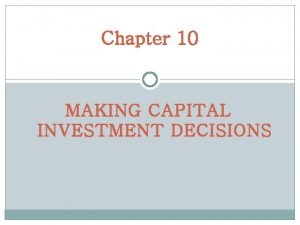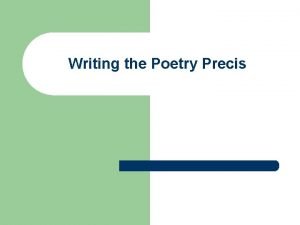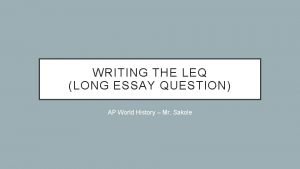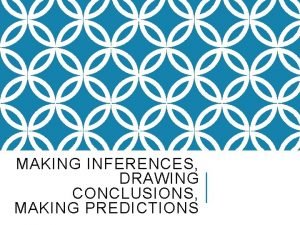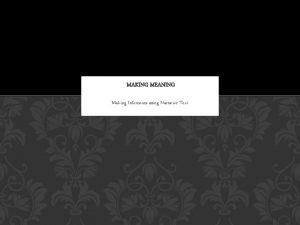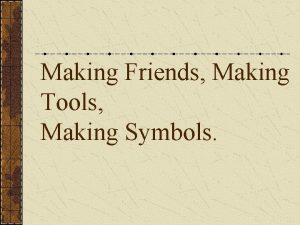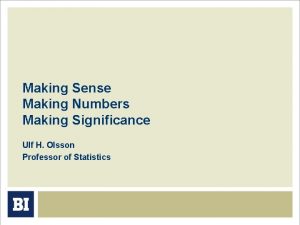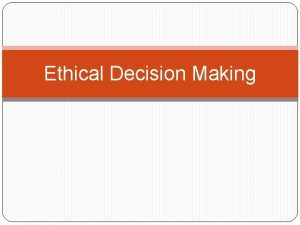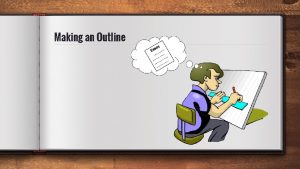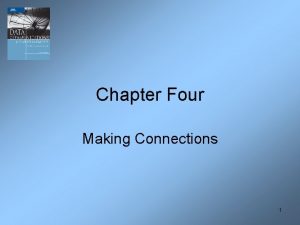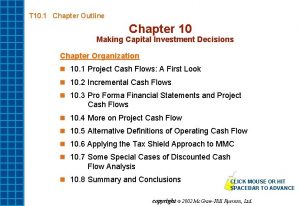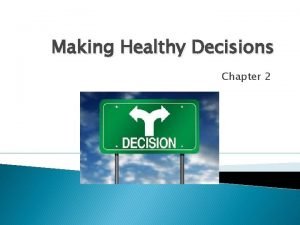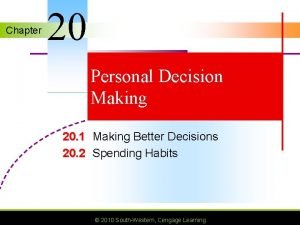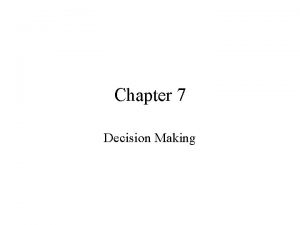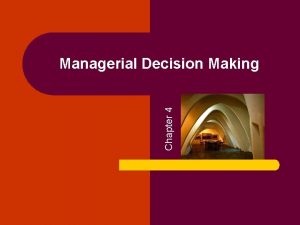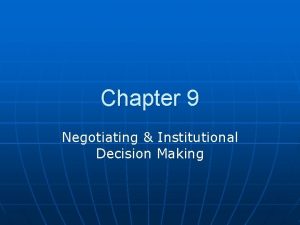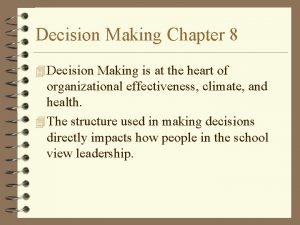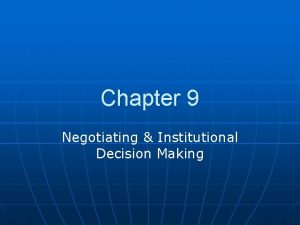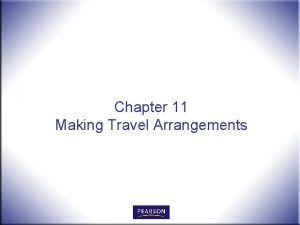T 10 1 Chapter Outline Chapter 10 Making
















































- Slides: 48

T 10. 1 Chapter Outline Chapter 10 Making Capital Investment Decisions Chapter Organization n 10. 1 Project Cash Flows: A First Look n 10. 2 Incremental Cash Flows n 10. 3 Pro Forma Financial Statements and Project Cash Flows n 10. 4 More on Project Cash Flows n 10. 5 Alternative Definitions of Operating Cash Flow n 10. 6 Applying the Tax Shield Approach to the Majestic Mulch and Compost Company CLICK MOUSE OR HIT SPACEBAR TO ADVANCE Irwin/Mc. Graw-Hill ©The Mc. Graw-Hill Companies, Inc. 1999

T 10. 1 Chapter Outline (concluded) n 10. 7 Some Special Cases of Discounted Cash Flow Analysis n 10. 8 Summary and Conclusions CLICK MOUSE OR HIT SPACEBAR TO ADVANCE Irwin/Mc. Graw-Hill ©The Mc. Graw-Hill Companies, Inc. 1999

T 10. 2 Fundamental Principles of Project Evaluation n Fundamental Principles of Project Evaluation: Project evaluation - the application of one or more capital budgeting decision rules to estimated relevant project cash flows in order to make the investment decision. Relevant cash flows - the incremental cash flows associated with the decision to invest in a project. The incremental cash flows for project evaluation consist of any and all changes in the firm’s future cash flows that are a direct consequence of taking the project. Stand-alone principle - evaluation of a project based on the project’s incremental cash flows. Irwin/Mc. Graw-Hill ©The Mc. Graw-Hill Companies, Inc. 1999

T 10. 3 Incremental Cash Flows n Key issues: u u Irwin/Mc. Graw-Hill When is a cash flow incremental? Terminology A. Sunk costs B. Opportunity costs C. Side effects D. Net working capital E. Financing costs F. Other issues ©The Mc. Graw-Hill Companies, Inc. 1999

T 10. 4 Example: Preparing Pro Forma Statements n Suppose we want to prepare a set of pro forma financial statements for a project for Norma Desmond Enterprises. In order to do so, we must have some background information. In this case, assume: 1. Sales of 10, 000 units/year @ $5/unit. 2. Variable cost/unit is $3. Fixed costs are $5, 000/year. Project has no salvage value. Project life is 3 years. 3. Project cost is $21, 000. Depreciation is $7, 000/year. 4. Net working capital is $10, 000. 5. The firm’s required return is 20%. The tax rate is 34%. Irwin/Mc. Graw-Hill ©The Mc. Graw-Hill Companies, Inc. 1999

T 10. 4 Example: Preparing Pro Forma Statements (continued) Pro Forma Financial Statements Projected Income Statements Sales $______ Var. costs ______ $20, 000 Fixed costs 5, 000 Depreciation 7, 000 “EBIT” $______ Taxes (34%) 2, 720 Net income $______ Irwin/Mc. Graw-Hill ©The Mc. Graw-Hill Companies, Inc. 1999

T 10. 4 Example: Preparing Pro Forma Statements (concluded) Projected Balance Sheets 0 NWC 1 $______ 2 3 $10, 000 NFA 21, 000 ______ 0 Total $31, 000 $24, 000 $17, 000 $10, 000 Irwin/Mc. Graw-Hill ©The Mc. Graw-Hill Companies, Inc. 1999

T 10. 5 Example: Using Pro Formas for Project Evaluation n Let’s use the information from the previous example to do a capital budgeting Project operating cash flow (OCF): EBIT $8, 000 Depreciation +7, 000 Taxes -2, 720 OCF Irwin/Mc. Graw-Hill $____ ©The Mc. Graw-Hill Companies, Inc. 1999

T 10. 5 Example: Using Pro Formas for Project Evaluation (continued) n Project Cash Flows 0 1 2 OCF $12, 280 NWC Sp. ______ Cap. Sp. -21, 000 Total Irwin/Mc. Graw-Hill ______ $12, 280 3 $12, 280 ______ $12, 280 $______ ©The Mc. Graw-Hill Companies, Inc. 1999

T 10. 5 Example: Using Pro Formas for Project Evaluation (concluded) n Capital Budgeting Evaluation: NPV = $22, 280/1. 20 3 = -$31, 000 + $12, 280/1. 201 + $12, 280/1. 20 2 + $655 IRR = 21% PB = 2. 3 years AAR 25. 76% = $5280/{(31, 000 + 24, 000 + 17, 000 + 10, 000)/4} = n Should the firm invest in this project? Why or why not? Irwin/Mc. Graw-Hill ©The Mc. Graw-Hill Companies, Inc. 1999

T 10. 6 Example: Estimating Changes in Net Working Capital n In estimating cash flows we must account for the fact that some of the incremental sales associated with a project will be on credit, and that some costs won’t be paid at the time of investment. How? Answer: Estimate changes in NWC. Assume: 1. 2. Fixed asset spending is zero. Net working capital spending is $200: 0 1 Change A/R $100 $200 +100 ___ INV 100 150 +50 ___ -A/P 100 50 -50 ___ NWC $100 $300 Irwin/Mc. Graw-Hill S/U Chg. NWC = $_____ ©The Mc. Graw-Hill Companies, Inc. 1999

T 10. 6 Example: Estimating Changes in Net Working Capital (continued) n Now, estimate operating and total cash flow: Sales $300 Costs 200 Depreciation 0 EBIT $100 Tax 0 Net Income $100 OCF = EBIT + Dep. - Taxes = $100 Total Cash flow = OCF - Change in NWC - Capital Spending = Irwin/Mc. Graw-Hill -$______ ©The Mc. Graw-Hill Companies, Inc. 1999

T 10. 6 Example: Estimating Changes in Net Working Capital (concluded) n Where did the -$100 in total cash flow come from? n What really happened: Cash sales = $300 -______ Cash costs = (disbursements) $200 +______= $300 Cash flow out) $200 - 300 Irwin/Mc. Graw-Hill = = $200 (collections) = -$100 (= cash in - cash ©The Mc. Graw-Hill Companies, Inc. 1999

T 10. 7 Example: Fairways Equipment and Operating Costs Equipment requirements: Ball dispensing machine $ 2, 000 Ball pick-up vehicle 7, 000 Tractor and accessories 9, 000 $18, 000 n all depreciable equipment is Class 10, 30% n all equipment is expected to have a salvage value of 10% of cost after 6 years Balls and buckets $ 3, 000 n expenditures for balls and baskets are expected to grow to 5% per year Irwin/Mc. Graw-Hill ©The Mc. Graw-Hill Companies, Inc. 1999

T 10. 7 Example: Fairways Equipment and Operating Costs (concluded) Operating Costs (annual) Land lease $ 12, 000 Water 1, 500 Electricity 3, 000 Labor 30, 000 Seed & fertilizer Gasoline 2, 000 Working Capital Initial requirement = $3, 000 Working capital requirements are expected to grow at 5% per year for the life of the project 1, 500 Maintenance Insurance 1, 000 Misc. 1, 000 $53, 000 Irwin/Mc. Graw-Hill ©The Mc. Graw-Hill Companies, Inc. 1999

T 10. 8 Example: Fairways Revenues, Depreciation, and Other Costs Projected Revenues Year Irwin/Mc. Graw-Hill Buckets Revenues 1 20, 000 $60, 000 2 20, 750 62, 250 3 21, 500 64, 500 4 22, 250 66, 750 5 23, 000 69, 000 6 23, 750 71, 250 ©The Mc. Graw-Hill Companies, Inc. 1999

T 10. 8 Example: Fairways Revenues, Depreciation, and Other Costs (continued) Cost of balls and buckets Year Irwin/Mc. Graw-Hill Cost 1 $3, 000 2 3, 150 3 3, 308 4 3, 473 5 3, 647 6 3, 829 ©The Mc. Graw-Hill Companies, Inc. 1999

T 10. 8 Example: Fairways Revenues, Depreciation, and Other Costs (concluded) CCA for the six year life of the project Year Beg. UCC CCA 1 9000 6300 2 15300 4590 10710 3213 7497 4 7497 2249 5248 5 5248 1574 3674 6 3674 1102 2572 Irwin/Mc. Graw-Hill 2700 Ending UCC ©The Mc. Graw-Hill Companies, Inc. 1999

T 10. 9 Example: Fairways Pro Forma Income Statement Year 1 6 Revenues 2 3 4 $60, 000 62, 250 64, 500 66, 750 69, 000 71, 250 Variable costs 3, 000 3, 150 3, 308 3, 473 3, 647 3, 829 Fixed costs 53, 000 53, 000 Depreciation 2, 700 4, 590 3, 213 2, 249 EBIT 1, 510 4, 979 8, 028 10, 779 10, 747 Taxes 195 227 747 1, 204 1, 617 1, 612 Net income $ 1, 283 4, 232 6, 824 1, 300 Irwin/Mc. Graw-Hill 5 1105 1, 574 ©The 3, 674 9, 162 9, 135 Mc. Graw-Hill Companies, Inc. 1999

T 10. 10 Example: Fairways Projected Increases in NWC Projected increases in net working capital Year Net working capital Increase in NWC Irwin/Mc. Graw-Hill 0 3, 000 1 3, 150 2 3, 308 158 3 3, 473 165 4 3, 647 174 5 3, 829 182 6 4, 020 -3, 829 ©The Mc. Graw-Hill Companies, Inc. 1999

T 10. 11 Example: Fairways Cash Flows n Operating cash flows: Operating + Depreciation - Taxes= cash flow Year EBIT 0 $ 1 1, 300 2, 700 195 3, 805 2 1, 510 4, 590 227 5, 873 3 4, 979 3, 213 747 7, 445 4 8, 028 2, 249 1, 204 9, 073 5 10, 779 1, 574 1, 617 10, 736 6 10, 747 3, 674 1, 612 12, 809 Irwin/Mc. Graw-Hill 0$ 0$ 0$ 0 ©The Mc. Graw-Hill Companies, Inc. 1999

T 10. 11 Example: Fairways Cash Flows (concluded) n Total cash flow from assets: Operating - Increases Capital Total Year cash flow in NWC - spending = cash flow 0 $ 1 3, 805 150 0 3, 655 2 5, 873 158 0 5, 715 3 7, 445 165 0 7, 280 4 9, 073 174 0 8, 899 5 10, 736 182 0 10, 554 6 12, 809 -3, 829 -1, 530 18, 168 Irwin/Mc. Graw-Hill 0 $ 3, 000 $18, 000 ©The -$21, 000 Mc. Graw-Hill Companies, Inc. 1999

T 10. 12 Alternative Definitions of OCF Let: Irwin/Mc. Graw-Hill OCF = flow operating cash S = sales C = operating costs D = depreciation Tc = corporate tax rate ©The Mc. Graw-Hill Companies, Inc. 1999

T 10. 12 Alternative Definitions of OCF (concluded) n The Tax-Shield Approach OCF = (S - C - D) + D - (S - C - D) x Tc = (S - C) x ( 1 - Tc) + (D x Tc) = (S - C) x (1 - Tc) + depreciation tax shield n The Bottom-Up Approach OCF = (S - C - D) + D - (S - C - D) x Tc = (S - C - D) x (1 - Tc) + D = Net income + depreciation n The Top-Down Approach OCF = Irwin/Mc. Graw-Hill (S - C - D) + D - (S - C - D) x Tc = (S - C) - (S - C - D) x Tc = Sales - costs - taxes ©The Mc. Graw-Hill Companies, Inc. 1999

T 10. 13 Chapter 10 Quick Quiz -- Part 1 of 2 n Now let’s put our new-found knowledge to work. Assume we have the following background information for a project being considered by Gillis, Inc. n See if you can calculate the project’s NPV and payback period. 1. Required NWC investment = $40; cost = $60; 3 year life 2. Annual sales = $100; annual costs = 50; straight line depreciation to $0 3. Salvage value = $10; tax rate = 34%, required return = 12% u The after-tax salvage is $10 - ($___ - ___ )(. 34) = $6. 6 u OCF = (100 - 50 - 20) + 20 - (100 - 50 - 20)(. 34) = $_____ Irwin/Mc. Graw-Hill ©The Mc. Graw-Hill Companies, Inc. 1999

T 10. 13 Chapter 10 Quick Quiz -- Part 1 of 2 (concluded) n Project cash flows are thus: 0 OCF 1 2 3 $39. 8 Add. NWC _____ Cap. Sp. _____ -60 _____ $39. 8 NPV = Payback period = Irwin/Mc. Graw-Hill _____ $39. 8 $86. 4 $ ______ 2. 24 years ©The Mc. Graw-Hill Companies, Inc. 1999

T 10. 14 Example: A Cost-Cutting Proposal Consider a $10, 000 machine that will reduce pretax operating costs by $3, 000 per year over a 5 -year period. Assume no changes in net working capital and a scrap value of $1, 000 after five years. For simplicity, assume straight-line depreciation. The marginal tax rate is 34% and the appropriate discount rate is 10%. Using the tax-shield approach to find OCF = (S - C) x (1 - Tc) + (D x Tc) = (0 - (-3, 000))(. 66) + (2, 000 x. 34) = $1, 980 + $680 = $2, 660 The after-tax salvage value is market value - (market value - book value) x (Tc) $1, 000 - ($1, 000 - 0)(. 34) = $660 Irwin/Mc. Graw-Hill ©The Mc. Graw-Hill Companies, Inc. 1999

T 10. 14 Example: A Cost-Cutting Proposal (concluded) The cash flows are Year Irwin/Mc. Graw-Hill OCF Capital spending. Total 0 0 -10, 000 1 2, 660 0 2, 660 2 2, 660 0 2, 660 3 2, 660 0 2, 660 4 2, 660 0 2, 660 5 2, 660 +660 3, 320 ©The Mc. Graw-Hill Companies, Inc. 1999

T 10. 15 Chapter 10 Quick Quiz -- Part 2 of 2 Evaluating Cost Cutting Proposals Cost = Depreciation Life = Salvage = Savings = Tax rate = Add. to NWC $900, 000 = $180, 000 5 years $330, 000 $500, 000/year, pretax 34 percent = -$220, 000 (note the minus sign) n 1. After-tax cost saving: $500 K x (______) = $______ /year. n 2. Depreciation tax shield: $180 K x ______ = $______ /year. n 3. After-tax salvage value: $330 K - ($330 K - 0)(. 34) = $______ n 4. The cash flows are thus: Irwin/Mc. Graw-Hill ©The Mc. Graw-Hill Companies, Inc. 1999

T 10. 15 Chapter 10 Quick Quiz -- Part 2 of 2 (concluded) 0 1 2 3 4 5 AT saving $330. 0 K Tax shield 61. 2 K “OCF” _____ $391. 2 K NWC Sp. _____ Cap. Sp. -900 K 217. 8 K - ____ $391. 2 K _____ $391. 2 K $330. 0 K $391. 2 K The IRR is about 50%, so it looks good! Irwin/Mc. Graw-Hill ©The Mc. Graw-Hill Companies, Inc. 1999

T 10. 16 Example: Setting the Bid Price The Army is seeking bids on Multiple Use Digitizing Devices (MUDDs). The contract calls for 4 units per year for 3 years. Labor and material costs are estimated at $10, 000 per MUDD. Production space can be leased for $12, 000 per year. The project will require $50, 000 in new equipment which is expected to have a salvage value of $10, 000 after 3 years. Making MUDDs will require a $10, 000 increase in net working capital. Assume a 34% ax rate and a required return of 15%. Use straight-line depreciation. Operating Increases Year cash flow in NWC spending 0 $ 1 OCF 0 0 OCF 2 OCF 0 0 OCF 3 OCF 10, 000 + 6, 600 OCF + 16, 600 Irwin/Mc. Graw-Hill 0 Capital Total = cash flow -$10, 000 -$50, 000 -$60, 000 ©The Mc. Graw-Hill Companies, Inc. 1999

T 10. 16 Example: Setting the Bid Price (continued) n Taking the present value of $16, 600 in year 3 (= $10, 915 at 15%) and netting against the initial outlay of -$60, 000 gives Year Total cash flow 0 -$49, 085 1 OCF 2 OCF 3 OCF The result is a three-year annuity with an unknown cash flow of OCF. Irwin/Mc. Graw-Hill ©The Mc. Graw-Hill Companies, Inc. 1999

T 10. 16 Example: Setting the Bid Price (continued) n The annuity factor for 3 years at 15% is 2. 283. At NPV = $0, NPV = $0 = -$49, 085 + (OCF x 2. 283), thus OCF = $49, 085/2. 283 = $21, 500 n Using the bottom-up approach to calculate OCF, OCF = Net income + depreciation $21, 500 = Net income + $50, 000/3 = Net income + $16, 667 Net income = $4, 833 n Next, noting annual costs are $40, 000 + $12, 000 Net income = (S - C - D) x (1 - Tc) $4, 833 = (S x. 66) - (52, 000 x. 66) - (16, 667 x. 66) S = $50, 153/. 66 = $75, 989. 73 Hence, sales need to be $76, 000 per year or $19, 000 per MUDD Irwin/Mc. Graw-Hill ©The Mc. Graw-Hill Companies, Inc. 1999

T 10. 16 Example: Setting the Bid Price (continued) Background (in $000): n 1. Bid calls for 20 units/year; 3 years n 2. Costs are $25/unit hardware; $10/unit other; $35 total n 3. Cap. spending of $250; depreciation = $250/5 = $50/year n 4. Salvage in 3 years is half of cost, $125. n 5. NWC investment of $60 n 6. r = 16%; tax rate = 39% n 7. The after-tax salvage value is $125 - ($____ - ____) x. 39 = $115. 25 Irwin/Mc. Graw-Hill ©The Mc. Graw-Hill Companies, Inc. 1999

T 10. 16 Example: Setting the Bid Price (continued) n The cash flows are: 0 OCF 1 2 3 $OCF Add. to NWC -$60 +60 Cap. Sp. -250 _______ -$310 $OCF + _______ Find the OCF such that the NPV is zero at 16%: +$310, 000 - 175, 250/1. 163 = OCF x (1 - 1/1. 163)/. 16 $197, 724. 74 = OCF x 2. 2459 OCF = $88, 038. 50/year Irwin/Mc. Graw-Hill ©The Mc. Graw-Hill Companies, Inc. 1999

T 10. 16 Example: Setting the Bid Price (concluded) If the required OCF is $88, 038. 50, what price must we bid? Sales ? Costs 700, 000. 00 Depreciation 50, 000. 00 EBIT $_____ Tax 24, 319. 70 Net income $ 38, 038. 50 Sales = $62, 358. 20 + 50, 000 + 700, 000 = $812, 358. 20/year The bid price should be $812, 358. 20/___ = ____/unit Irwin/Mc. Graw-Hill ©The Mc. Graw-Hill Companies, Inc. 1999

T 10. 17 Example: Equivalent Annual Cost Analysis n Two types of batteries are being considered for use in electric golf carts at City Country Club. Burnout brand batteries cost $36, have a useful life of 3 years, will cost $100 per year to keep charged, and have a salvage value of $5. Longlasting brand batteries cost $60 each, have a life of 5 years, will cost $88 per year to keep charged, and have a salvage value of $5. Assume straight-line depreciation. Irwin/Mc. Graw-Hill ©The Mc. Graw-Hill Companies, Inc. 1999

T 10. 17 Example: Equivalent Annual Cost Analysis (continued) n Using the tax shield approach, cash flows for Burnout are: OCF = (Sales - costs)(1 - Tc) + Depreciation(Tc) = (0 - 100)(. 66) + 12(. 34) = -$66 + 4 = -$62 cash flow Irwin/Mc. Graw-Hill Year Operating cash flow Capital Total - spending 0 $ 0 -$ 36 -36 1 -62 0 - 62 2 -62 0 - 62 3 -62 + 3. 3 - 58. 7 ©The = Mc. Graw-Hill Companies, Inc. 1999

T 10. 17 Example: Equivalent Annual Cost Analysis (continued) n Using the tax shield approach, OCFs for Longlasting are: OCF Total flow - 60 - 54 = (Sales - costs)(1 - Tc) + Depreciation(Tc) = (0 - 88)(. 66) + 12(. 34) = -$58 + 4 = -$54 Operating Year - spending 0 $0 1 - 54 2 - 54 Irwin/Mc. Graw-Hill OCF 0 0 - 54 0 ©The 4 = cash -$ 60 - 54 3 Capital Mc. Graw-Hill Companies, Inc. 1999 0

T 10. 17 Example: Equivalent Annual Cost Analysis (continued) n Using a 15% required return, calculate a cost per year for the two batteries. Calculate PV of cash flows The present value of total cash flows for Burnout is -$175. 40 The present value of total cash flows for Longlasting is -$239. 40 Irwin/Mc. Graw-Hill ©The Mc. Graw-Hill Companies, Inc. 1999

T 10. 17 Example: Equivalent Annual Cost Analysis (concluded) What 3 year annuity has the same PV as Burnout? The annuity factor for 3 years at 15% is 2. 283 -$175. 40 = EAC 2. 283 EAC = -$175. 40/2. 283 = -$76. 83 What 5 year annuity has the same PV as Longlasting? The annuity for 5 years at 15% is 3. 352 -$239. 40 = EAC 3. 352 EAC = -$239. 40/3. 352 = -$71. 42 Irwin/Mc. Graw-Hill ©The Mc. Graw-Hill Companies, Inc. 1999

T 10. 18 Solution to Problem 10. 5 n A proposed new project has projected sales of $65, 000, costs of $40, 000, and depreciation of $2, 250. Calculate OCF using the four approaches described in the chapter. Sales $65, 000. 00 Costs $40, 000. 00 Depreciation 2, 250. 00 EBT $22, 750. 00 Taxes (@ 34%)7, 735. 00 Net Income Irwin/Mc. Graw-Hill $15, 015. 00 ©The Mc. Graw-Hill Companies, Inc. 1999

T 10. 18 Solution to Problem 10. 5 (concluded) OCF = 7, 735 = EBIT + D - T = $22, 750 + 2, 250 $17, 265 OCF = = S - C - T = $65, 000 - 40, 000 - 7, 735 $17, 265 OCF = (S - C)(1 - Tc) + Tc. D = ($65, 000 - 40, 000)(1 -. 34) + . 34(2, 250) OCF Irwin/Mc. Graw-Hill = $17, 265 = NI + D = $15, 015 + 2, 250 = $17, 265 ©The Mc. Graw-Hill Companies, Inc. 1999

T 10. 19 Example n Bendog’s Franks is looking at a new sausage system with an installed cost of $290, 000. The project will be depreciated straight-line to zero over its 5 -year life, at the end of which it will be scrapped for $50, 000. The sausage system will save the firm $90, 000 per year in pretax operating costs, and requires an initial investment in net working capital of $27, 000. If the tax rate is 34 percent and the discount rate is 10 percent, what is the NPV of this project? Irwin/Mc. Graw-Hill ©The Mc. Graw-Hill Companies, Inc. 1999

T 10. 19 Example (concluded) Annual depreciation expense = $290, 000/5 = $58, 000 After-tax salvage value = ($______ )(1 -. 34) = $______ OCF = $______ $90, 000 (1 -. 34) + (. 34)(36, 000) = So, NPV = -$290, 000 - $27, 000 + $_______ (PVIFA 10%, 5) Irwin/Mc. Graw-Hill + ($_____ + $_____)/1. 15 = $______ ©The Mc. Graw-Hill Companies, Inc. 1999

T 10. 20 Example n A proposed cost-saving device has an installed cost of $450, 000. It will be used in a 5 -year project. . The required initial net working capital investment is $30, 000, the marginal tax rate is 35%, and the discount rate is 12%. The device has an estimated year 5 salvage value of $75, 000. What level of pretax cost savings do we require for this project to be profitable? n First, calculate the annual depreciation expenses are given as: D 1 = $150, 000 D 2 = $199, 980 D 3 = $66, 690 D 4 = $33, 345 Irwin/Mc. Graw-Hill ©The Mc. Graw-Hill Companies, Inc. 1999

T 10. 20 Example (continued) n Next, calculate cash flows in years 1 through 5: n After-tax salvage value = $75, 000(1 -. 35) = $48, 750 n OCF 1 = (S - C)(1 -. 35) + . 35($150, 000) OCF 2 = (S - C)(1 -. 35) + . 35($199, 980) OCF 3 = (S - C)(1 -. 35) + . 35($66, 690) OCF 4 = (S - C)(1 -. 35) + . 35($33, 345) OCF 5 = (S - C)(1 -. 35) Irwin/Mc. Graw-Hill ©The Mc. Graw-Hill Companies, Inc. 1999

T 10. 20 Example (concluded) n Finally, set NPV equal to 0 and solve for the unknown term, C: 0 = -$450, 000 - $30, 000 + (S - C)(1 -. 35)(PVIFA 12%, 5) +. 35[($150, 000)/1. 12 + $199, 980/1. 122 + $66, 690/1. 123 + $33, 345/1. 124] + ($48, 750 + $30, 000)/1. 125 n Then (S - C)(1 -. 35)(PVIFA 12%, 5) = $____ , and C = $131, 712. Irwin/Mc. Graw-Hill ©The Mc. Graw-Hill Companies, Inc. 1999
 Flavorful sentence
Flavorful sentence Making an outline example
Making an outline example Making a difference outline
Making a difference outline Making inferences
Making inferences War making and state making as organized crime summary
War making and state making as organized crime summary A repetition of or return to criminal behavior
A repetition of or return to criminal behavior Romans outline by chapter
Romans outline by chapter Components of research proposal
Components of research proposal Give me liberty chapter 27 outline
Give me liberty chapter 27 outline Methodology chapter outline
Methodology chapter outline Chapter 38 a world without borders outline
Chapter 38 a world without borders outline 24 chapter outline
24 chapter outline Chapter 12 hunger games questions
Chapter 12 hunger games questions Chapter 31 societies at crossroads outline
Chapter 31 societies at crossroads outline General hero
General hero Chapter 2 learning goals outline sociology answers
Chapter 2 learning goals outline sociology answers Chapter 1 outline
Chapter 1 outline Chapter 1 outline
Chapter 1 outline Chapter 30
Chapter 30 Chapter 2 outline
Chapter 2 outline Book of acts study outline
Book of acts study outline 24 chapter outline
24 chapter outline 24 chapter outline
24 chapter outline Apush chapter 16 conquering a continent outline
Apush chapter 16 conquering a continent outline Chapter 6 prices and decision making assessment answers
Chapter 6 prices and decision making assessment answers Chapter 14 section 4 making the peace
Chapter 14 section 4 making the peace Chapter 11 decision making and relevant information
Chapter 11 decision making and relevant information Chapter 2 economic systems and decision making
Chapter 2 economic systems and decision making Management chapter 5 planning and decision making
Management chapter 5 planning and decision making Chapter 3 financial decision making
Chapter 3 financial decision making Chapter 2 economic systems and decision making
Chapter 2 economic systems and decision making Chapter 9 making healthy food choices
Chapter 9 making healthy food choices Sickle cell karyotype
Sickle cell karyotype Copyright
Copyright Chapter 30 the making of industrial society
Chapter 30 the making of industrial society Chapter 29 the making of industrial society
Chapter 29 the making of industrial society Relevant cost for decision making solution chapter 13
Relevant cost for decision making solution chapter 13 Making wellness a lifestyle
Making wellness a lifestyle Chapter 2 economic systems and decision making answer key
Chapter 2 economic systems and decision making answer key Chapter 11 decision making and relevant information
Chapter 11 decision making and relevant information Chapter 2 management supervision and decision making
Chapter 2 management supervision and decision making Decision making and relevant information
Decision making and relevant information Management chapter 5 planning and decision making
Management chapter 5 planning and decision making Cca tax shield formula excel
Cca tax shield formula excel Chapter 1 section 3 economic choices and decision making
Chapter 1 section 3 economic choices and decision making The making of industrial society chapter 29
The making of industrial society chapter 29 Nwc change
Nwc change Rhetorical precis example
Rhetorical precis example Leq structure
Leq structure

